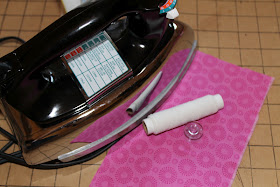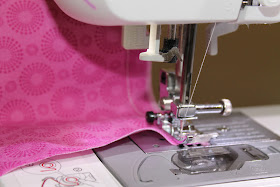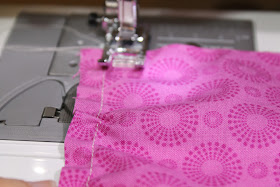Sewing Lesson: How to Shir Fabric
Alright, Ladies, you asked for it and I hope you like it!
Tutorial:
How to Shir Fabric
1. Gather Supplies:
*one spool of elastic thread
*an empty bobbin
* a 4 inch long x 8 inch wide piece of fabric for practicing
*an iron
*a spray water bottle (or you can just fill a bowl with some water)
*sewing machine
**Suggested Fabric: Ttry it on whatever you have in your stash...apparel cotton, quilter's cotton, jersey (old t-shirt), rayon...etc....this is just practice...so there's no pressure for a finished project. (But just wait until you see shirring in action and your creative mind will start spinning with cute clothing ideas!)
**Below: This is a close-up of elastic thread for shirring. It comes on a cardboard spool and is found next to the elastic in the fabric store. (It is less than $3.00 if you are curious.)
2. Take your elastic thread and hand wind your bobbin. You want to wind it with some tension. If your thread is too loose it won't work. You want it pretty snug on there, but not so snug that you are stretching the elastic until it breaks as you wind it. Just firmly wrap it around. It will take about a minute or a minute and a half to hand wind it. (You might get bored, but go with it!)
*There is no easy way around this, the machine cannot do it for you.
Below: Start winding the elastic thread firmly
Below: Wound and ready! Hold the end of the thread when you are done.
If you drop it, it unwinds pretty quickly and you will have to start over.
3. Insert your elastic wound bobbin into your sewing machine and thread your machine as usual. Use the same old thread you normally sew with and a needle size that matches your fabric choice.
4.. Lay your fabric RIGHT SIDE UP...Let me say that again because I know it sounds SO WEIRD! Lay your fabric RIGHT SIDE UP. Want to know why? The elastic thread is in your bobbin, which makes the stitches under the fabric. You want the elastic to be on the underneath side of your fabric/the wrong side of your fabric (it isn't pretty, but it helps make something pretty!)
*If you accidentally start sewing with your fabric wrong side up, just rip out your stitches or cut off that part and start again. Don't let one or two or ten mistakes stop you from practicing and learning this!
Below: Keep your fabric right side up.
5. Start sewing along the width of your fabric (fabric is right side up) using a 5/8 inch seam allowance and backstitch at the beginning, then continue sewing until you reach the end of your fabric.
** Do NOT backstitch at the end of your fabric.
*** HINTS: Use a straight stitch and regular stitch tension. Do not change any settings on your machine.
Below: Sew to the end of the fabric in a straight line.
**Below: When you turn it around you may see this elastic thread piece under your fabric. Pull it. It sometimes gets stuck in your first few stitches. Just pull until it releases. You aren't messing up any of the stitches, you are just moving it out of the way so it doesn't get sewn over when you turn your fabric around.
Below: Fabric is turned and the presser foot is lined up paralled to the previously sewn line.
*The fabric may start to gather a little, that's fine...keep going.
Below: Try to keep your lines parallel.
7. Sew again until you reach the other end. Then lift the presser foot and needle, turn your fabric 180 degrees, line up the presser foot, lower it and sew another line.
Continue this process until you have sewn 6 lines. Backstitch at the end.
Below: Done!
Below: This is what the wrong side of your fabric looks like before you iron it.
8. Now the fun part! Lay your fabric right side up on your ironing board.
9. Spray the shirred part lightly with water from your spray water bottle. (If you do not have one, just wet your hands and pat the fabric until it is damp.)
10. Using an iron setting for the fabric you are using PRESS DOWN with your iron onto one part of the shirred lines for 10-12 seconds. YOU WILL hear a SIZZLE :) That's OKAY! It means you're doing it correctly! YAY! *Do not move your iron back and forth like you do when you iron a shirt.
Below: Sizzle, Sizzle!
11. Lift your iron and move it over so you can press down the next part of the shirred lines. You will continue until the whole piece of fabric has been dampened and pressed with an iron (to sizzle it) :).
Below: When you lift your iron you will see it starting to gather. Woohoo! It really does work!
Below: Press the next spot with an iron. Repeat until all shirred lines are done.
12. Take off your iron one last time and look at your beautiful piece of shirred fabric!!
13. Now try it again and again until you try it on a sewing project! Think: skirt waistbands, bubble tops, sundresses, dresses and much more!
**When you practice, try it on different fabrics to see which shir (shrink and gather) more than others. I've found that rayon and cotton shir the most. Linen is pretty heavy so it will shir the least.
Below: My sister, Laurie, is wearing the first shirred dress I made about 2 years ago.
Below: Women's Shirred Sundress sewing pattern
Let me know if you try it!! Email me a picture of your shirred lines or shirred project.
I wish you all HAPPY SEWING!
*I would love to hear what you think. Did this help? Will you try it? I hope so!!
*Let me know if you have any questions.
Any more topics you would like tutorials on, ladies?
Happy Sewing!
Jenny
Jenny
Owner and Designer/ Seamingly Smitten sewing patterns
Like us on Facebook to find out about new pattern releases and FREE sewing tutorials.
Like us on Facebook to find out about new pattern releases and FREE sewing tutorials.
























thanks for the tip about finding the elastic thread by the elastic. I've looked several times for it by the thread and even asked at Joannes... No ones seems to think they have it. I will check by the elastic next time!
ReplyDeleteNot sure if you got an answer to this but they do have it at Joann’s. I know that i got the gutterman brand and you just have to look at the thread rack and you’ll find (probably on the lower right) a few different colors of elastic thread on a regular plastic spool.
DeleteThis is so great thanks! I didnt know about the ironing trick and wondered why my shirring was so wonky!
ReplyDeleteWow that is awesome! I feel like a fabric magician now! Thanks!
ReplyDeleteThanks for the tutorial. As a new sewer this is a skill I am happy to see a tutorial for and to try out.
ReplyDeleteGreat tutorial. I have a vintage shirred summer dress pattern on flickr that this would really work for.
ReplyDeletehttp://www.flickr.com/photos/14033721@N06/2546465005/in/set-72157604048311089/
This is great, but how do you measure the width of fabric needed?
ReplyDeleteYou usually multiply it by 1.5. So if your daughter's waist is 20, you will cut a piece that is about 30 inches wide if you are using a lightweight material. The thicker the material, the less it will gather, so multiply your width by 1.3, cut and begin shirring. Construct your project as usual. Hope this helps!
ReplyDeleteJenny
Seamingly Smitten
Gran tutorial!yo tampoco entendida porque no lograba que quedara bien encogido mi trabajo.Hacia todo lo contrario! Evitaba pasar la plancha sobre el elástico.Soy totalmente ignorante de las redes,y no encuentro como seguirla por correo electrónico, tendré que encontrar la forma de encontrar su camino .Buen fin de semana!
ReplyDeleteI can't wait to try this!! Thank you!
ReplyDeleteThank you for sharing this!
ReplyDeleteAwesome! Sundresses coming up!
ReplyDeleteI'm going to try a t-shirt skirt (from sew like my mom blog) but I guess I'll be going back to find the right elastic thread. I don't think the one I got is going to work. Cant wait to try this!
ReplyDeleteCan you cut this like you can cut shirred material from the store? Or would the elastic thread just pop out?
ReplyDeleteLisaJB you would cut your pattern pieces first and then shir them. If you cut them after being shirred the elastic would pop. A way to prevent that would be to draw your cutting lines on your shirred fabric and then sew 1/8 inch away from that line using a regular straight stitch and regular thread. This would hold the shirring in place, so when you cut it, it would not pop the elastic.
ReplyDeleteJenny
Just a heads up...the Dritz brand elastic thread is garbage! Don't waste your money.
ReplyDeletelove this tuto ;)
ReplyDeleteI have done this on sleeves, but when I sew the seams up on sides then put it on the elastic always pops out. Is there any way to lock the elastic thread so it doesn't pull out?
ReplyDeleteThanks.
Hello from France!! I need some help, please. I am finding that my cotton winds itself around the elastic after I have started and managed to get a few inches! It then is so difficult to cut free, as you may imagine. I took my machine into a shop yesterday to ask for help and the lady told me it wouldn't work because the elastic was thicker than the cotton and proceeded to show me by sewing narrow elastic on the underneath of the material using a zig-zag stitch. I worked it out that I would need to deduct 10 inches in order for the dress to fit my grand-daughter so cut the elastic to the required length and did a trial run! Not easy to do it - much prefer the shirring elastic if only it would work for me. Any advice?
ReplyDeleteI love the dressmaking fabric you used, and you always have such great tutorials with wonderful pics.
ReplyDeleteIs it possible to shir without a sewing machine...using just needle and thread
ReplyDeleteI stumbled upon your blog post about sewing on paper and I must say, it's such a unique and fascinating technique! Your tutorial is incredibly helpful, and I appreciate the step-by-step instructions and the beautiful examples you've shared.
ReplyDeletehttps://www.promocodehq.com/blog/free-shein-gift-card/
Supporting artists like you is essential for the growth and vitality of the creative community. By investing in handmade items, art supplies, and resources, we help foster an environment where artists can continue to inspire and share their talents with the world.
ReplyDeletehttps://www.frugalishness.com/stores-like-ross/
This shirring tutorial is a game-changer for my sewing projects! Your clear instructions make it easy to learn. And when it comes to getting the fabrics I need for shirring, I always check out #HowtoStackCouponsonShein for great deals. Thanks for sharing your expertise! piada coupon
ReplyDelete